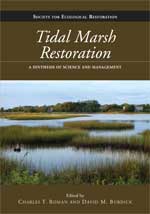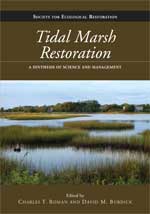 NARRAGANSETT, R.I. – January 2, 2013 – About 50 percent of the salt marshes in the Northeast have been destroyed by human development, and many of those that remain have been severely degraded by roads and other crossings, restricting tidal flows and limiting their ability to provide flood protection, water quality maintenance and wildlife habitat.
NARRAGANSETT, R.I. – January 2, 2013 – About 50 percent of the salt marshes in the Northeast have been destroyed by human development, and many of those that remain have been severely degraded by roads and other crossings, restricting tidal flows and limiting their ability to provide flood protection, water quality maintenance and wildlife habitat.
A new book, co-edited by a University of Rhode Island scientist and including chapters written by several others affiliated with URI, provides the scientific foundation and practical guidance to reverse this trend and restore many of these marshes.
Tidal Marsh Restoration: A Synthesis of Science and Management was edited by Charles Roman, a coastal ecologist for the National Park Service and professor-in-residence at the URI Graduate School of Oceanography, and David Burdick, a research associate professor at the University of New Hampshire. It was published by Island Press.
“New England is ahead of the curve on restoring these marsh systems, perhaps because we’re in a region where the coastline is highly developed,” said Roman, who has been studying coastal marshes for over 30 years. “Because of the intensity of tidal restrictions to our coastal areas, it was a logical event for scientists and managers to begin to restore these systems, and moreover, to bring them together in this book to report on their findings and help guide future marsh restoration efforts.”
“It’s straightforward to restore these systems,” Roman added. “Simply by returning the natural tidal flow, you restore the hydrology of these systems, and the natural vegetation communities come back, fish communities return, and water quality parameters are improved.”
According to Roman, a resident of East Greenwich, coastal zone stewards in New England have been restoring tidal marshes for more than two decades. The Coastal Resources Management Council, Save the Bay and others have been leaders in restoration efforts in Rhode Island, as have coastal managers in other New England states.
Roman’s book compiles the current state of knowledge of the science and practice of salt marsh restoration, including numerous case studies from throughout New England.
A chapter on the affect of salt marsh restoration on invasive Phragmites was co-written by URI Associate Professor Laura Meyerson and her graduate student Kimberly Dibble, while Professor Peter Paton, Professor Emeritus Frank Golet, and Adjunct Professor Brian Tefft contributed to a chapter about the restoration of the Galilee Bird Sanctuary in Narragansett. URI alumni Kenneth Raposa, Susan Adamowicz, Dennis Myshrall and Larry Oliver also co-authored chapters in the book.
“We looked for the best people in the region to be co-authors, and many of them turned out to be here at URI,” Roman said.
Tidal Marsh Restoration is a valuable resource for managers, planners, regulators, environmental and engineering consultants, and others engaged in planning, designing and implementing projects aimed at restoring tidal flow in salt marshes. It is available at www.islandpress.org or by calling 800-621-2736.0

